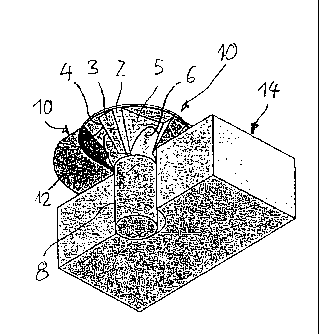Some of the information on this Web page has been provided by external sources. The Government of Canada is not responsible for the accuracy, reliability or currency of the information supplied by external sources. Users wishing to rely upon this information should consult directly with the source of the information. Content provided by external sources is not subject to official languages, privacy and accessibility requirements.
Any discrepancies in the text and image of the Claims and Abstract are due to differing posting times. Text of the Claims and Abstract are posted:
| (12) Patent: | (11) CA 2677270 |
|---|---|
| (54) English Title: | HEAD OF A COUNTERSUNK SCREW |
| (54) French Title: | TETE DE VIS A TETE FRAISEE |
| Status: | Granted and Issued |
| (51) International Patent Classification (IPC): |
|
|---|---|
| (72) Inventors : |
|
| (73) Owners : |
|
| (71) Applicants : |
|
| (74) Agent: | MARKS & CLERK |
| (74) Associate agent: | |
| (45) Issued: | 2014-05-13 |
| (86) PCT Filing Date: | 2008-01-17 |
| (87) Open to Public Inspection: | 2008-08-14 |
| Examination requested: | 2012-10-02 |
| Availability of licence: | N/A |
| Dedicated to the Public: | N/A |
| (25) Language of filing: | English |
| Patent Cooperation Treaty (PCT): | Yes |
|---|---|
| (86) PCT Filing Number: | PCT/EP2008/000354 |
| (87) International Publication Number: | WO 2008095593 |
| (85) National Entry: | 2009-07-31 |
| (30) Application Priority Data: | ||||||
|---|---|---|---|---|---|---|
|
The invention relates to the head of a countersunk screw with a lower side which has at least one supporting surface (2), which forms part of a rotational surface about the screw axis (7) and can nestle against a correspondingly contoured countersunk surface (11) of an add-on part (10), and has at least one depression (6) which is delimited by a cutting edge (4) at its end which runs downwards, as seen in the screwing-in direction (e) of the countersunk screw. The invention is distinguished in that in front of the supporting surface (2), as seen in the screwing-in direction (e), there is an approach surface (3) which butts against said supporting surface, is inclined radially inwards and, at its upwardly running, free end, has the cutting edge (4) which, over its length, maintains a radial distance (a) from the rotational surface to the inside.
La présente invention concerne une tête de vis à tête fraisée présentant un côté inférieur qui présente au moins une surface d'appui (2) qui forme une partie d'une surface de rotation autour de l'axe (7) de la vis et peut s'adapter à une surface chanfreinée (11) de contours correspondants d'une pièce rapportée (10); et au moins un retrait (6) qui est délimité par une arête coupante (4) à son extrémité descendante lorsque l'on considère la vis dans son sens de vissage (e). L'invention se caractérise en ce que, lorsque l'on considère la vis dans son sens de vissage (e), une surface d'avancement (3) inclinée radialement vers l'intérieur, contiguë à la surface d'appui (z), se trouve en amont de ladite surface d'appui, la surface d'avancement présentant à son extrémité montante libre l'arête coupante (4) qui garantit la préservation d'un espace radial (a) vers l'intérieur sur sa longueur par rapport à la surface de rotation.
Note: Claims are shown in the official language in which they were submitted.
Note: Descriptions are shown in the official language in which they were submitted.

2024-08-01:As part of the Next Generation Patents (NGP) transition, the Canadian Patents Database (CPD) now contains a more detailed Event History, which replicates the Event Log of our new back-office solution.
Please note that "Inactive:" events refers to events no longer in use in our new back-office solution.
For a clearer understanding of the status of the application/patent presented on this page, the site Disclaimer , as well as the definitions for Patent , Event History , Maintenance Fee and Payment History should be consulted.
| Description | Date |
|---|---|
| Common Representative Appointed | 2019-10-30 |
| Common Representative Appointed | 2019-10-30 |
| Inactive: Late MF processed | 2019-02-05 |
| Letter Sent | 2019-01-17 |
| Grant by Issuance | 2014-05-13 |
| Inactive: Cover page published | 2014-05-12 |
| Pre-grant | 2014-02-28 |
| Inactive: Final fee received | 2014-02-28 |
| Notice of Allowance is Issued | 2013-12-09 |
| Letter Sent | 2013-12-09 |
| Notice of Allowance is Issued | 2013-12-09 |
| Inactive: Q2 passed | 2013-11-30 |
| Inactive: Approved for allowance (AFA) | 2013-11-30 |
| Amendment Received - Voluntary Amendment | 2013-05-22 |
| Amendment Received - Voluntary Amendment | 2012-11-23 |
| Letter Sent | 2012-10-16 |
| Request for Examination Received | 2012-10-02 |
| Request for Examination Requirements Determined Compliant | 2012-10-02 |
| All Requirements for Examination Determined Compliant | 2012-10-02 |
| Inactive: Cover page published | 2009-11-02 |
| Inactive: Notice - National entry - No RFE | 2009-10-02 |
| Inactive: First IPC assigned | 2009-09-28 |
| Application Received - PCT | 2009-09-28 |
| National Entry Requirements Determined Compliant | 2009-07-31 |
| Application Published (Open to Public Inspection) | 2008-08-14 |
There is no abandonment history.
The last payment was received on 2013-12-30
Note : If the full payment has not been received on or before the date indicated, a further fee may be required which may be one of the following
Please refer to the CIPO Patent Fees web page to see all current fee amounts.
Note: Records showing the ownership history in alphabetical order.
| Current Owners on Record |
|---|
| LUDWIG HETTICH & CO. |
| Past Owners on Record |
|---|
| ULRICH HETTICH |